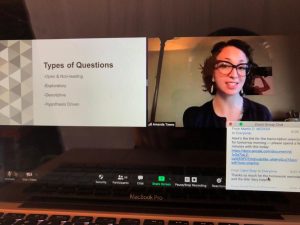Looking to the Future of Oral History Work
by Amanda Tewes, May 2021 Guest Contributor

At this point, it is almost a cliche to point out that COVID-19 has indelibly reshaped our lives and work. But for many oral history operations, last year was for coping with the upheaval; this year is for rebuilding the practice. For us at the Oral History Center and for oral history practitioners around the world, this has also meant a fundamental change in how we conduct interviews—namely, going remote.
Even as we see bright spots in COVID-19 case reductions, oral history practitioners are starting to game out what interviewing best practices may be in the future, especially in regards to recording technologies. Many, like myself, are calling to embrace this moment, when so many individuals of all generations have become more familiar with remote interview platforms like Zoom; the potential seems great to record even more interviews that could not be completed before. Still others are champing at the bit to return to in-person interviews and yearn to leave remote ones behind.
However, oral history as a practice has always been adaptable, especially when it comes to technology. Early, heavy equipment like reel-to-reel machines gave way to cassette recorders, and later to light-weight digital cameras and recorders. And of course, today oral historians have embraced phone calls and Zoom as a way to continue interviewing narrators while social distancing—not to mention simply reaching narrators who live far away. And like today, adoption of these various technologies in oral histories has always mirrored cultural moments and the needs of the interview.
And yet, some still lament that the current technological expansion of oral history into remote interviews due to COVID-19 has forced us to lose important elements of rapport with our narrators, as well as the opportunity to physically and emotionally connect to particular places that have resonance in the interviews themselves. (For instance, I interviewed several individuals about their experiences with certain theme parks in the parks themselves, and the location of these interviews undoubtedly had an impact on their content.)
Indeed, there are tradeoffs to this new remote approach: do narrators have access to a computer and reliable Internet? How will Zoom fatigue impact interviews? And how does the inability to hug for joy or comfort influence rapport between interviewers and narrators? But I’m not so sure that in this switch to remote interviews we have lost more than we have gained.
Since shelter-in-place began for us in the San Francisco Bay Area in March of 2020, my interview schedule has been busier than ever—sometimes with multiple interviews on the same day. Thanks to Zoom, I have been able to interview narrators living across the country, all from the comfort of their own homes. And frankly, like other interviewers, I have still been able to build rapport with narrators by centering discussions of our mutual pandemic experiences. I have found that exaggerating my facial expressions during interviews translates well over the computer screen, and communicates to narrators not only that I am listening, but that I am still responding to the content of their words, despite our distance. In my experience, remote interviewing has not eliminated the emphasis on the human interaction between interviewer and narrator.
Moving forward, oral history practitioners may find themselves retaining at least a partial reliance on remote interviewing possibilities such as Zoom in order to allow for flexible schedules not reliant on cross-country interviewer travel, to keep project costs low that otherwise might have required extensive travel or expensive equipment, to ensure safety of narrators and interviewers in a world in which the spread of COVID variants remain uncertain, to maintain accessibility for individuals with mobility challenges, and the list goes on.
And while I do mourn the (hopefully momentary) loss of in-person interviews, I continue to see possibilities in remote oral history work. No matter the changing health landscapes, I believe remote interviewing will remain an important component of oral historians’ toolkits moving forward.